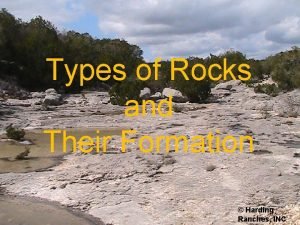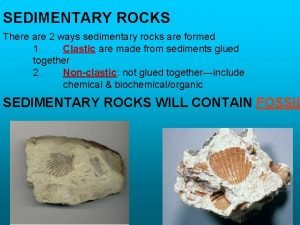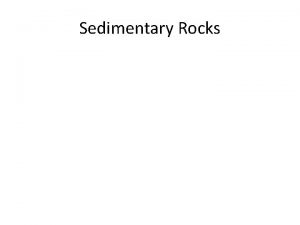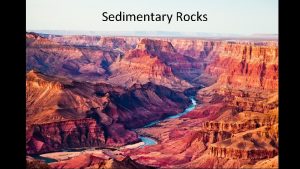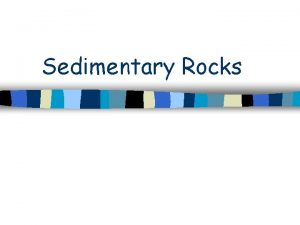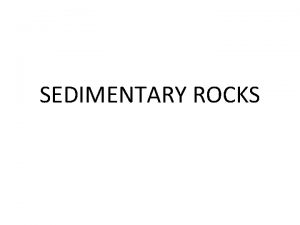SEDIMENTARY ROCKS Sedimentary rocks as the word implies







- Slides: 7

SEDIMENTARY ROCKS ØSedimentary rocks, as the word implies, are formed due to aggregation and compaction of sediments. ØThe word ‘Sedimentary’ has been derived from Latin word sedimentum which means settling down. ØSedimentary rocks are also called as stratified or layered rocks because these rocks have different layers or strata of different types of sediments. ØThus, layer after layers of sediments and debris are regularly deposited. Continuous sedimentation increased the weight and pressure and thus different layers are consolidate and compacted to form sedimentary rocks.

CHARACTERISTICS OF SEDIMENTARY ROCKS Ø Most of sedimentary rocks are deposited due to continuous deposition of sediments in water bodies (Lakes, ponds, basin, river and sea) but some time these are also formed at the land surface, e. g. loess, rocks of sand dunes, alluvial fans and cones. Ø Sedimentary rocks are formed of sediments derived from the older rocks, plant and animal remains and thus these rocks contain fossils of plants and animals. Ø Sedimentary rocks are found over the largest surface area of the globe. It is believed that about 75 per cent of the surface area of the globe is covered by sedimentary rocks whereas igneous and metamorphic rocks cover the remaining 25 per cent area.

Continued Ø Inspite of their largest coverage the sedimentary rocks constitute only 5 percent of the composition of the earth crust whereas 95 percent of the crust is composed of igneous and metamorphic rocks. Ø Sedimentary rocks contain several layers or strata but these are seldom crystalline rocks. Ø Like igneous rocks sedimentary rocks are not found in massive forms such as batholiths, laccoliths, dykes and sill etc. Ø Layers of sedimentary rocks are seldom found in original and horizontal manner. Ø Most of the sedimentary rocks are permeable and porous but a few of them are also non-porous and impermeable.

METAMORPHIC ROCKS • ‘Metamorphic rocks include rocks that have been changed either in form or composition without disintegration’ (P. G. Worcester, 1948). • Metamorphic rocks, as the word ‘metamorphism’ implies are formed due to changes in the forms of other rocks. • Originally, the word metamorphism has been derived from the word ‘metamorphose’ which means change in form. • Metamorphic rocks are generally formed due to change in form of sedimentary and igneous rocks. Some time, even previously formed metamorphic rocks are again metamorphosed.

CONTINUED • It may be mentioned that the process of metamorphism simply means change in form. • When already formed metamorphic rocks are again metamorphosed, the process is known as remetamorphism. • When the rocks are metamorphosed to the greatest intensity, the process is known as intense metamorphism. • The change in the form of the rocks during the process of metamorphism takes place in two ways, (1) Physical metamorphism (pertaining to changes in textural composition of the rocks) (2) Chemical metamorphism (leading to changes in the chemical composition of the rocks. Some times, both the processes of metamorphism become operative together.

AGENTS OF METAMORPHISM • Heat is the most important factor for the development of metamorphic rocks from preexisting parent rocks. • Compression resulting from convergent horizontal movement caused by endogenetic forces causes folding in rocks bed. • Solution chemically active hot gases and water while passing through the rocks change their chemical composition.

TYPES OF METAMORPHISM • On the basis of the nature of agents




